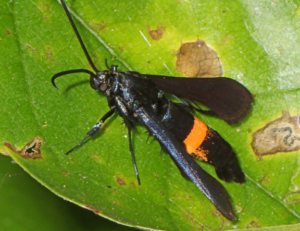Blights, bugs and leaf biters, oh my! There are undoubtedly several pests that can cause your fruit trees hardship, if not harm. Identifying which of the several B.C. fruit tree pests have invaded and what needs to be done to prevent them is crucial to saving your trees, your fruit, and your wallet. Of course, multiple types of pests are in the Okanagan Valley and surrounding area, all of which do different types of damage to trees. Some are only a minor threat until their numbers are too many, and others could do a significant amount. This blog will discuss how to identify signs of pests effectively and what you should look out for specifically as the weather warms up.
April Showers Bring May’s Devourers
As the weather mellows out and the last frosts fade, insects will be returning or hatching to begin their seasonal cycle. This time of year will be when infestations of fruit tree pests begin. Of course, there can be different insect pests that invade a tree at the same time, and an infestation of one type can lead to another. The early signs of an infestation of fruit tree pests can be spotted, though, by looking for the following:

1. Overwintering Eggs
Some insects, including mites, moths and aphids, will overwinter eggs, resulting in the hatching of their larva as the weather warms. As trees begin to bud and blossom, discovering signs of infestation will be primarily collected around any buds, leaves or the bark. Look for clusters of eggs around these areas. Those will be your primary indicators of an infestation. Certain insects will have different types of eggs, and they will be clustered in different ways. Aphid eggs tend to be concentrated on a few trees in a planting. Aphid eggs will be coloured brown or black to gray, and look like “soot” covering a leaf. Overwintering moths that target fruit trees, such as the Apple Ermine Moth, will lay their eggs. The egg mass will have a flattened, slightly convex oval form about 0.5 inches in diameter and will be coloured yellow initially, then turn red to gray when they mature.
2. Increased Activity Around the Tree
When fruit trees are under attack from insect pests, another sign of their presence during the first weeks of May will be an increase in activity around the tree itself. Certain pests will be drawn in by the presence of other pests roosting in your tree or the opportunities your trees provide. Wasp queens will emerge from hibernation at this time as well and begin construction of a nest in an ideal location, usually a fruit tree due to the proximity of food. They, or workers, if it’s late enough in the season, will be bringing materials to the selected site to build a nest. Ants will be foraging and may strip a tree of bark, leaves, and flowers. As aphids are a favourite food of ants, any infestations that have begun will attract ants to the tree. They may then proceed to attack the tree itself and create further problems for it.
3. Signs of Boring
Boring insects will begin to target trees to lay their eggs and ensure that their larva has a substantial amount of food to engorge themselves on when available. Multiple types of insect larvae and insects will burrow into trees to devour the bark and wound trees. The signs of borer infestation appear on the woody parts of fruit trees, including branches, buds, trunks and twigs. A common red flag of burrowing infestations will be darkly coloured patches of bark and small wood cuttings, which often feature a spiral shape. Another will be white powdery frass, which is waste material excreted by the insects, also indicating borers. Cuttings and grass typically appear near the base of fruit trees, including apple and pear trees. Mice and rats will take advantage of any prior damage done around the base of fruit trees, creating nests there and further burrowing into the injured bark.
Moulds and Fungus
Unfortunately, insects aren’t the only pests you’ll need to contend with. The areas of the Okanagan that won’t get as much sun will be prone to moulds and funguses that will take advantage of the warm weather. Insects attacking the tree and infesting it will increase the likelihood of mould, blight and fungus forming! If you notice insect activity, be on the lookout for any fungal infection or mould signs. There may be abnormal growth, discoloration, or wilting in the leaves or needles. You may see discoloration or scabs on the bark. There may even be patches of the fungus itself growing on the tree! A tree’s trunk may also show signs of a fungus with mushroom-shaped fruiting bodies speckling the drip line of the tree. Preventative care can be taken, such as getting your trees sprayed to ensure that rot is not a more significant issue than it could be.
Recognize These Signs?
In conclusion, these indicators are your first warning signs of an infestation beginning. At the first sign of overwintering eggs, increased activity or signs of boring in your fruit trees, it’s vital to get your fruit trees treated for pests as soon as possible. It is also essential to arrange preventative spraying as mould and fungus can attack trees as viciously as insects.
Arcadia Tree & Lawn Care creates custom programs for businesses and residential clients that minimize the impact on the Okanagan micro-climate while spraying for pests. Our technicians are certified by the Province of BC under the Integrated Pest Management approach, ensuring best practices are used, reducing the impact on the environment and safety of everyone around. Contact us today for a custom quote that will address the specific needs of your trees.

